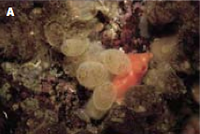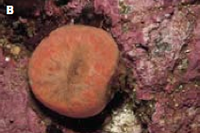TUNICATES (sea squirts), SALPS, ACORN WORMS
Includes tunicates or sea squirts, sea porks, ascidians and salps as well as the vertebrates.
A hollow nerve cord supported by a firm but flexible notochord (stiffening rod) defines this group. Throat slits called stigmata or pharyngeal perforations, features common to chordates, are only found in the earliest life stages of all advanced members of the group. In the vertebrates (p. 361) this brief stage steadily gives way, through embryological development, to a more complex and recognizable adult anatomy. With tunicates and salps, on the other hand, this early stage—called a tadpole larva—metamorphoses into a totally different adult form, as a caterpillar turns into a butterfly. In tunicates the stigmata divide many times and form a large filtering sac for feeding on tiny plankton.
Essentially an adult tunicate is a fine-mesh filtering sac and associated internal organs within a tough external sac made of a cellulose-like material called tunicin. The basic tunicate is attached to something solid and has two openings at the top called siphons. Two different species of solitary tunicates illustrating this basic design are featured in photograph A: yellow-coloured disc-top tunicate (CH16) and orange broadbase tunicate (CH7). Plankton-laden seawater enters through the in-current siphon, filters through the mesh bag and exits through the ex-current siphon. Colonial versions, often called compound tunicates, consist of variously interdependent but small basic tunicate units called zooids, as shown in photograph B: red ascidian (CH35).
Approximately 100 species of non-vertebrate chordates live in the marine waters of the Pacific Northwest.


